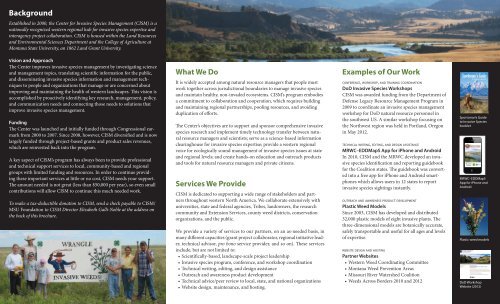CISM brochure (PDF) - Center for Invasive Plant Management
CISM brochure (PDF) - Center for Invasive Plant Management
CISM brochure (PDF) - Center for Invasive Plant Management
Create successful ePaper yourself
Turn your PDF publications into a flip-book with our unique Google optimized e-Paper software.
Background<br />
Established in 2000, the <strong>Center</strong> <strong>for</strong> <strong>Invasive</strong> Species <strong>Management</strong> (<strong>CISM</strong>) is a<br />
nationally recognized western regional hub <strong>for</strong> invasive species expertise and<br />
interagency project collaboration. <strong>CISM</strong> is housed within the Land Resources<br />
and Environmental Sciences Department and the College of Agriculture at<br />
Montana State University, an 1862 Land Grant University.<br />
Vision and Approach<br />
The <strong>Center</strong> improves invasive species management by investigating science<br />
and management topics, translating scientific in<strong>for</strong>mation <strong>for</strong> the public,<br />
and disseminating invasive species in<strong>for</strong>mation and management techniques<br />
to people and organizations that manage or are concerned about<br />
improving and maintaining the health of western landscapes. This vision is<br />
accomplished by proactively identifying key research, management, policy,<br />
and communication needs and connecting those needs to solutions that<br />
improve invasive species management.<br />
Funding<br />
The <strong>Center</strong> was launched and initially funded through Congressional earmark<br />
from 2000 to 2007. Since 2008, however, <strong>CISM</strong> diversified and is now<br />
largely funded through project-based grants and product sales revenues,<br />
which are reinvested back into the program.<br />
A key aspect of <strong>CISM</strong>’s program has always been to provide professional<br />
and technical support services to local, community-based and regional<br />
groups with limited funding and resources. In order to continue providing<br />
these important services at little or no cost, <strong>CISM</strong> needs your support.<br />
The amount needed is not great (less than $50,000 per year), so even small<br />
contributions will allow <strong>CISM</strong> to continue this much needed work.<br />
To make a tax-deductible donation to <strong>CISM</strong>, send a check payable to <strong>CISM</strong>/<br />
MSU Foundation to <strong>CISM</strong> Director Elizabeth Galli-Noble at the address on<br />
the back of this <strong>brochure</strong>.<br />
What We Do<br />
It is widely accepted among natural resource managers that people must<br />
work together across jurisdictional boundaries to manage invasive species<br />
and maintain healthy, non-invaded ecosystems. <strong>CISM</strong>’s program embodies<br />
a commitment to collaboration and cooperation, which requires building<br />
and maintaining regional partnerships, pooling resources, and avoiding<br />
duplication of ef<strong>for</strong>ts.<br />
The <strong>Center</strong>’s objectives are to support and sponsor comprehensive invasive<br />
species research and implement timely technology transfer between natural<br />
resource managers and scientists; serve as a science-based in<strong>for</strong>mation<br />
clearinghouse <strong>for</strong> invasive species expertise; provide a western regional<br />
voice <strong>for</strong> ecologically sound management of invasive species issues at state<br />
and regional levels; and create hands-on education and outreach products<br />
and tools <strong>for</strong> natural resource managers and private citizens.<br />
Services We Provide<br />
<strong>CISM</strong> is dedicated to supporting a wide range of stakeholders and partners<br />
throughout western North America. We collaborate extensively with<br />
universities, state and federal agencies, Tribes, landowners, the research<br />
community and Extension Services, county weed districts, conservation<br />
organizations, and the public.<br />
We provide a variety of services to our partners, on an as-needed basis, in<br />
many different capacities (grant project collaborator, regional initiative leader,<br />
technical advisor, pro bono service provider, and so on). These services<br />
include, but are not limited to:<br />
• Scientifically-based, landscape-scale project leadership<br />
• <strong>Invasive</strong> species program, conference, and workshop coordination<br />
• Technical writing, editing, and design assistance<br />
• Outreach and awareness product development<br />
• Technical advice/peer review to local, state, and national organizations<br />
• Website design, maintenance, and hosting.<br />
Examples of Our Work<br />
conference, workshop, and training coordination<br />
DoD <strong>Invasive</strong> Species Workshops<br />
<strong>CISM</strong> was awarded funding from the Department of<br />
Defense Legacy Resource <strong>Management</strong> Program in<br />
2009 to coordinate an invasive species management<br />
workshop <strong>for</strong> DoD natural resource personnel in<br />
the southwest US. A similar workshop focusing on<br />
the Northwest region was held in Portland, Oregon<br />
in May 2012.<br />
technical writing, editing, and design assistance<br />
MRWC –EDDMapS App <strong>for</strong> iPhone and Android<br />
In 2010, <strong>CISM</strong> and the MRWC developed an invasive<br />
species identification and reporting guidebook<br />
<strong>for</strong> the Coalition states. The guidebook was converted<br />
into a free app <strong>for</strong> iPhone and Android smartphones<br />
which allows users in 12 states to report<br />
invasive species sightings instantly.<br />
outreach and awareness product development<br />
Plastic Weed Models<br />
Since 2003, <strong>CISM</strong> has developed and distributed<br />
32,000 plastic models of eight invasive plants. The<br />
three-dimensional models are botanically accurate,<br />
safely transportable and useful <strong>for</strong> all ages and levels<br />
of expertise.<br />
website design and hosting<br />
Partner Websites<br />
• Western Weed Coordinating Committee<br />
• Montana Weed Prevention Areas<br />
• Missouri River Watershed Coalition<br />
• Weeds Across Borders 2010 and 2012<br />
Sportsman’s Guide<br />
to <strong>Invasive</strong> Species<br />
booklet<br />
MRWC–EDDMapS<br />
App <strong>for</strong> iPhone and<br />
Android<br />
Plastic weed models<br />
DoD Workshop<br />
Website (2012)
















